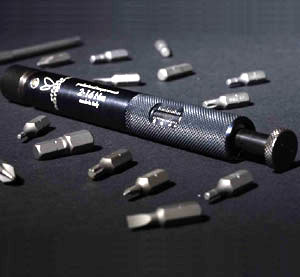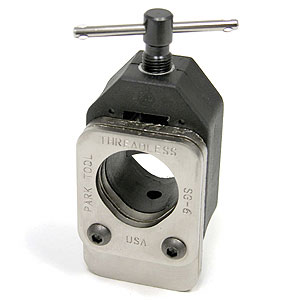Torque wrenches (and one in particular)

Since time immemorial (that is, since I was in my 20s), torque wrenches were and are a must-have bike biz tool. If you didn't want to smoosh your crank too far onto the squarehole BB axle, you set your torque wrench to 32 foot pounds, or thereabouts. You protected your seat binder braze-on, your stem bolts, heck, all sorts of stuff, from failure.
It's still true today. But it's a different sort of true. I don't need to worry as much about the precise torque applied to my crank bolt today. On the other hand, I'm much more concerned about water bottle screws and seat binders, because the nuts into which these bolts and screws are threaded are embedded in the frame, as are headset bearing surfaces. The consequences of over-tightening can be quite high in today's world of carbon frames and forks.
I have three torque wrenches, and I use them all, depending on how much torque I need to apply, and what tool is on the other end. The biggest one is outfitted with a half-inch drive, and is obviously for tightening big things. I use it for cassette lock rings, because the spline tools I prefer accept a half-inch drive. The next one down is a quarter-inch drive, but that one has largely been replaced by the Giustaforza. Yes, that little black thing is a torque wrench!

The nice thing about the Giustaforza, which comes in either the somewhat pricey ($249) version with the case, or the fairly reasonable ($185) version, is that I can actually take it with me on the ride. Why would I want to do that, you might ask? I've got a behind the saddle bottle carrier on my Cervelo P3C, and I take my spare tire and tools in a water bottle. I can fit into this bottle the Giustaforza, all the various Allen and driver bits, along with my spare tube and compressed air, without any hassle. If I've got to stop and re-tighten my seat binder, or a water bottle screw, I can do so using the right setting.
I've also got this 3T Ventus LTD aero bar to worry about, which is also expensive at $1200, and it's got 3mm and 5mm screws that cannot be safely over-tightened.
Common torque values for this P3C are as follows:
• Water bottle cage bolts – 2 to 3 N•m
• Stem Top cap – Apply only enough torque to remove all headset
play while ensuring it still rotates freely. 1 to 2 Nm recommended.
• Aero seatpost rear wedge bolt – 6 N•m
• Carbon TT seatpost (P2C and P3C) saddle clamp bolt – 12 N•m
The Giustaforza comes with about a dozen bits, and these are the sort of hex bits that would go in your cordless drill. This means all of my cordless drill hex bits can go in the Giustaforza as well, including nut drivers as well as that handy adapter I have that is hex drive to quarter-inch drive. This allows the Giustaforza to accept all my quarter-inch drive sockets.

The Giustaforza uses Newton-meters as its default metric. The bike industry, which used to exclusively measure in foot- or inch-pounds, seems to be moving over to Newton-meters (Nm). It requires about a third more torque to produce one foot-pound than to generate a Newton-meter. So, if you wanted to put a new chainring on your crank, with steel chainring bolts, you'd tighten them to about 12 Nm, which is about the same as 9 foot-lbs.
It's not just the bike frames that you have to worry about. For example, think of all the carbon tubular elements that can get crushed through over-tightening. Carbon steer columns, Carbon handlebars (road and pursuit), carbon seat posts, carbon aero bar extensions. Hillary Biscay was up at the compound, and she had a problem with a Blackwell aero bar armrest that would not stay in place. The armrest clamp attached to the extension, and it turned out the extension had been crushed by the force of the armrest clamp. All of these carbon tubular elements have to be tightened according to spec.
Of course, it's not easy to know what that spec is. I might hearken back to the one-piece aerobar I'm riding at the moment: the Ventus LTD. The armrests attach to that bar with 3mm bolts, which tightens the extensions in place. The Ventus bar attaches to the steerer with 5mm bolts. I can't yet find torque values anywhere on the 3T website. Of course this is a brand new company. Still, this is a common problem, this inability to find in one place a list of torque values commonly needed for use in triathlon. Perhaps we'll be able to archive a page for just that purpose here on Slowtwitch.



